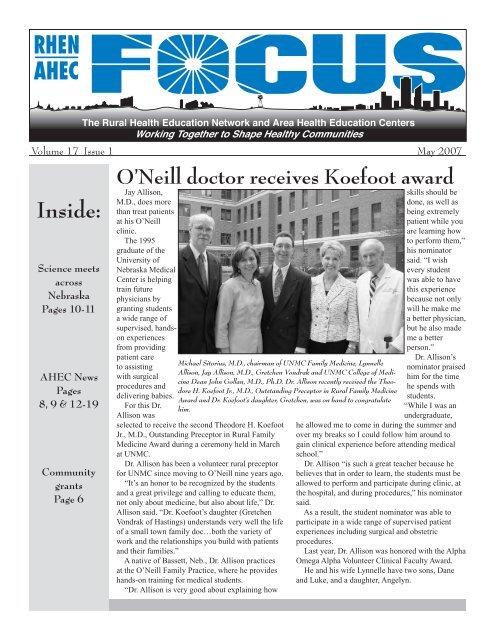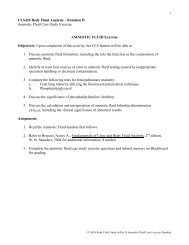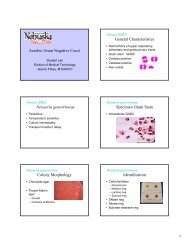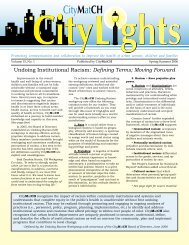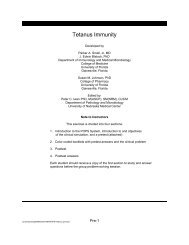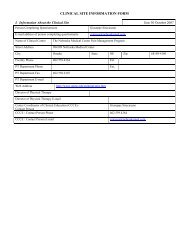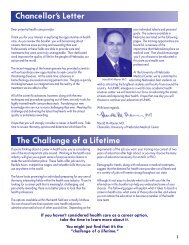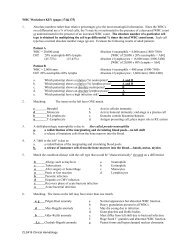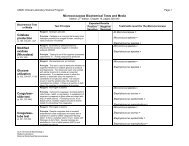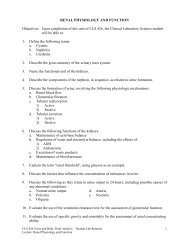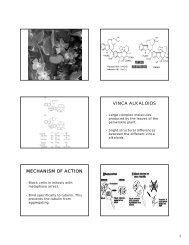Inside: - UNMC
Inside: - UNMC
Inside: - UNMC
Create successful ePaper yourself
Turn your PDF publications into a flip-book with our unique Google optimized e-Paper software.
What is SEARCH?This group of rural health research participants discusses the topic of injury and aging ofthe ruralNebraska population, the types of injuries that most often occur and what needs to be studied.Pictured clockwise from top left are: Terry Stentz, an associate professor from the University of Nebraska-Lincoln,Bill Hetzler, executive director of the Nebraska Department of Labor, Linda Prinz,co-owner of Prinz Grain & Feed, Inc., Lina Lander, Harvard University student, DeLynn Hay, UNLCooperative Extension and Nick Stergiou, professor of health, physical education and recreation atthe University of Nebraska at Omaha.Rural health focus of research retreatGrain dust, contaminated water,alternative fuels.These were just a few of the topicsexplored at the first Rural Health ResearchRetreat held in mid-March at MahoneyState Park.Educators, researchers and ruraladvocates came together to address theseand other issues affecting rural Nebraska.“It’s beneficial to come to a retreat likethis and share information with each otherthat will lead to better collaborations withexperts who can help solve public healthissues,” said Sherriann Moore, CEO ofthe Indian Health Services Hospital inWinnebago, Neb.Participants included scientists,physicians, public health providers andeducators.Other topics explored by researchparticipants ranged from obesity inrural Nebraska to behavioral healthto respiratory issues related to hogconfinement barns.Everyone was asked to identify the mostpressing concerns in each topic area, whatresearch is currently being done and whatstill needs to be done.“We will get several collaborativeresearch projects out of this retreat thatcould be submitted to federal agenciesfor funding,” said Elli Rogan, Ph.D., aprofessor of biochemistry and molecularbiology at the University of NebraskaMedical Center (<strong>UNMC</strong>).The retreat will only make it that mucheasier to establish those collaborations, Dr.Rogan said.“Today we made connections withothers that will help with future projects,”Dr. Rogan said. “I met Wehnona St. Cyr,a member of the Omaha Tribe, and foundout that they have a lot of health data thatcould be very useful to our researchers.”The retreat also helped explain whatresearchers need when conducting a studyand how they come to their conclusions,Moore said.It was exciting to see so many peopleshow strong interest in rural healthresearch topics,” said Susanna Von Essen,M.D., professor of pulmonary medicine at<strong>UNMC</strong> and retreat leader.“Many of the ideas that emerged couldresult in innovative research projects thatmight really help rural Nebraskans. I amlooking forward to seeing where this efforttakes us.”3SEARCH stands for Student/Resident Experiences And Rotationsin Community Health.The SEARCH Program is apartnership between <strong>UNMC</strong>’sRural Health Education Network,Nebraska’s Area Health EducationCenters and the National HealthService Corps.The purpose of the SEARCHProgram is to expand opportunitiesfor health professions students and/orresidents to enhance their communityinvolvement skills while alsogaining valuable clinical training inunderserved areas.These community health rotationsare available to health professionsstudents and residents mainly inprimary care.Students and/or residentsaccepted to the program are requiredto participate in one (or more)community projects during theirrotation. These projects should focuson the community by providingeducation, services and/or informationto individuals beyond thoseencountered during regular clinicalwork.The community projects arecoordinated between the student,preceptor and one of the Area HealthEducation Centers.Examples of past communityprojects include: patient educationand screenings for such at-riskpopulations as the elderly, migrantand seasonal farm workers or lowincome individuals; and working withadolescents and youth to increasephysical activity.If you are interested in learningmore about the SEARCH Programvisit the Web site at www.unmc.edu/dept/rhen and click on ‘NHSC-SEARCH’ on the left-hand side of thepage.For additional information, contactthe SEARCH Program CoordinatorDanie Frehse at (402) 559-3675 or viae-mail at: dfrehse@unmc.edu.
Pre-med students find cultural competency workshop enlighteningOn the first week of January, theNebraska AHEC program office hosted aweeklong workshop for 20 students fromeight colleges across the state.Throughout the program, variouspresenters tackled a variety of culturalsensitivity topics and weaved stories fromtheir lives into the information they sharedwith the students.Aaron Persinger, a pre-medicine studentfrom Kearney, Neb., said the workshopwas enlightening.“What surprised me most was how fastI was able to apply this new information,”Persinger said.“While job shadowing at a homelessshelter, I had the challenge andopportunity to take it upon myself toconverse with the clients and listen to theirstories. Without the skills we were taught,it would have been difficult to get them toopen up,” he said.Persinger also pointed out that it iscritical that everyone in the health fieldhave some type of exposure to culturalcompetency training, so they can betterserve the increasingly diverse populationsin the state.Chad Vogeler, a pre-medicine studentfrom Scotia, said: “This workshop is themost valuable educational experience thatI have had thus far. It stepped outside thenormal way in which things are taught. Wewere able to shadow health professionals,perform patient interviews, hear fromexperts on cultural competency and do indepthresearch.”During the workshop, the studentsworked on a research project to examinea clinical issue affecting underservedpopulations. On the final day of theworkshop, they presented their findingsduring a student forum.“Considering I am from WesternNebraska, where there is not muchdiversity, the workshop really openedmy eyes to a new perspective. I wouldencourage any students who areinterested in health care field to attendthis workshop,” said Sarah Milne, a prepharmacystudent from North Platte, Neb.The workshop was first offered sixyears ago through funding from theNebraska Healthcare Cash Fund (tobaccosettlement).It is now supported, in part, throughthe Rural Health Education Networkand Area Health Education Center fundsfrom the Health Resource and ServicesAdministration.Spreading excitement about scienceScience Education Parternship Awardpersonnel are getting ready for their secondyear of summer of activities.This summer, the program will focus onactivities for sixth- through eighth-gradeteachers and students from reservationschools.Chemistry, physical science, microscopy,earth science, technology, hands-onactivities, and resources for the sixth-,seventh-, and eighth-grade classroom willbe among the topics covered during thefour-day teacher workshop on the firstweek in June.This professional development opportunitywill help these teachers increasetheir science content knowledge, learnnew ways of engaging their students andnetwork with other teachers.Subsequent weeks will be followed byfour-day summer camps for middle schoolstudents from schools on the Rosebudand Yankton Sioux Reservations in SouthDakota, the Santee Sioux Reservation innortheastern Nebraska and from LibertyElementary School in Omaha.The camps will have many hands-onand inquiry-based activities for the students.Other outreach activities are currentlybeing arranged for students from the Winnebago,Omaha and Sisseton Tribes forlater in the summer.“We really hope to engage studentsand teachers so they are excited aboutscience,” said Maurice Godfrey, Ph.D.,principal investigator of the SEPA grant.“When students and their teachers betterunderstand and enjoy science, it becomesless intimidating.”Jonathan Jacobsen, a pre-medicine student fromMerna, Neb., tries on male Afghani clothing forsize.SAVE THE DATENorth American AgromedicineConsortium and Midwest RuralAgricultural Safety and HealthConferenceNovember 14 – 16, 2007Theme: Leading Edge Issues inAgricultural Public Health andOccupational Health;Specialty Agriculture; PotentialEnvironmental Health Impact ofBio-Fuels; and Food Safety Beginson the Farm.Watch for additional informationon registration to be linked towww.agromedicine.org and www.public-health.uiowa.edu/icash inthe near future.4
LEAD Program seeks new participantsOn Feb. 24, participantsof Nebraska LEAD classXXV spent the morning atthe University of NebraskaMedical Center (<strong>UNMC</strong>)hearing from variouscampus leaders and touringselect facilities such as TheLied Transplant Centerand Nebraska’s onlybiocontainment unit.The annual visit is anopportunity to learn aboutkey issues in health careresearch and advances inmedicine.David Crouse, Ph.D.,associate vice chancellorfor academic affairsand associate dean forgraduate studies, gavethe LEAD participants anoverview of <strong>UNMC</strong>.Other presenters andtheir topics included:Liliana Bronner, programcoordinator of the Rural Health Education Network, on thevarious activities of the RHEN program, including the AreaHealth Education Centers and the Rural Health OpportunitiesProgram; Janee Gelineau-Van Waes, D.V.M, Ph.D. assistantprofessor of genetics, cell biology and anatomy, on research onfungal toxins found in corn; Susanna Von Essen, M.D., professorof pulmonary and critical care medicine, on the effects of hogUtilizing a diverse group made up ofmore than 60 participants from variousages, races and ethnic backgrounds,the first Metro-area IntergenerationalDialogues were held.The event was sponsored by a coalitionof seven colleges and universities from theOmaha-Council Bluffs area.Participating institutions included:Clarkson College, Creighton UniversityMedical Center, the College of Saint Mary,Metropolitan Community College, IowaWestern Community College, MethodistCollege and the University NebraskaMedical Center Rural Health EducationNetwork.The Coalition of Metro collegesand universities are a sub group of the5confinements and feedlotson community health;Robert Lewis, Ph.D., leaderof the Cancer Genes andMolecular RegulationProgram in the EppleyCancer Center, on outreachactivities, future plans andan innovative lung cancerscreening project being donethroughout the state; KateBoulter, R.N., staff nurseat The Nebraska MedicalCenter, who gave the LEADclass a tour of the NebraskaBiocontainment Unitand transplant recipient,David Eggers, who gaveparticipants a tour throughThe Lied Transplant Center.More than 700 alumnihave graduated from theNebraska LEAD program todate. The program continuesto be recognized as oneof the finest and mostcomprehensive leadership development programs of its kind inthe nation.Currently, the Nebraska LEAD Program is solicitingapplications for the upcoming two-year program.The application deadline is June 15. To view the participantselection criteria and guidelines, visit the LEAD Web site at:http://lead.unl.edu.Kate Boulter, staff nurse with the biocontainment unit, allows, from left, Marv Stechof Osmond, Neb., James Carlson of Silver Creek, Neb., and Chad Carlson of Aurora,Neb., a chance to examine some of the equipment used to transport patients sufferingfrom an infectious disease.First Metro-area intergenerational dialogue a hit with young and oldMidwest Consortium on Service Learning.The group promotes, mobilizes andsupports the efforts of colleges anduniversities in Nebraska and South Dakotathat are united in strengthening theiracademic and co-curricular programsthrough service-learning in theirinstitutions, communities, state and nation.The February event was held atthe Omaha Public Schools TeacherAdministrative Center.The dialogue examined the perceptionsof different generations and the challengesthat face our youths and communities.The participants of the dialogue had theopportunity to discuss these issues andbrainstorm ways to address them.Sixth-graders through senior citizensprovided valuable insight into these issuesand offered many possible solutions.Sandra Sattler-Webber, Ph.D., fromthe University of Nebraska-Lincolnwas instrumental in the preparation andplanning of the event.Dr. Sattler-Webber has directedDialogues Across Nebraska for many ruralareas, but the Omaha-Council Bluffs areais the first dialogue to be held in an urbansetting.Trained college students from theparticipating coalition institutions alsohelped facilitate the dialogue.Each coalition institution will receivethe results of the program, which will thenbe used to seek ways to implement servicelearning projects across the metro area.
Grants awarded to 39 communities across the stateThe Rural Health Education Network(RHEN) at the University of NebraskaMedical Center (<strong>UNMC</strong>) has awarded 39grants to small communities around thestate.The purpose of the grants is to fundprojects aimed at improving communityhealth and to introduce Nebraska youth tohealth care careers.The grants are awarded through theRHEN office in conjunction with the fiveNebraska Area Health Education Centers(AHECs) around the state.The community grant program wasstarted in 1998 by RHEN DirectorRoxanna Jokela, who saw a need tofund local programs in small Nebraskacommunities to improve communityhealth, promote health care careerawareness or provide continuing educationopportunities to local professionals.Today, the grants are awarded on acompetitive basis and, to be considered,the agency applying must partnerwith other local organizations and/orinstitutions.For more information, contact yourlocal AHEC office.The following is a listing of the grantsawarded.Central Nebraska communities:Chase County: Wauneta-Palisade PublicHigh School received funding to continuethe opportunities in health care professionsprogram.Buffalo County: Good SamaritanHospital received funding for the careeropportunities for high school studentsprogram.Pleasanton High School receivedfunding for a video journal of health careerprofessions for high school students.Merrick County: Central City PublicSchools received funding to do anintroduction to health care careers forstudents.Franklin County: Good Beginings inFranklin County received funding for ahigh school health fair.Adams County: Central CommunityCollege in Hastings received funding to doa health occupations academy.Red Willow County: Southwest PublicSchools received funding for a health carepartnership for the future program.Hall County: St. Francis MedicalCenter received funding for a classroomassistance project.Grand Island Public Schools receivedfunding for a medical careers program.Central District Health Departmentreceived funding for a dental day program.Grand Island Northwest High Schoolreceived funding to assist with a healthcare career exploration program.Northern Nebraska communities:Hooker County: Mullen Public Schoolsreceived funding for CPR training.Wayne/Dixon County: WakefieldCommunity Schools received funding fora health fair.Holt County: O’Neil High Schoolreceived funding for a field trip to <strong>UNMC</strong>.Ewing Public Schools received fundingfor a kick tobacco and alcohol seminar.Antelope County: Elgin public schoolsreceived funding for a health careers,shadowing, graduate symposium.Tilden Community Hospital receivedfunding for CPR training.Madison County: Faith RegionalFoundation received funding for a summerinternship.Norfolk Catholic Jr./Sr. High receivedfunding for CPR training.Washington County: Arlington PublicSchools received funding for CPRinstructor and school training.Blaine County: Sandhills PublicSchools received funding for school andcommunity CPR training.Thurston County: UNL Extensionreceived funding for targeting youth for ahealthier tomorrow program.Knox County: Creighton Area HealthServices received funding for “KnoxCounty Kids Career Fair.”Cedar County: Hartington PublicSchools received funding for “OperationClean Hands.”Rock County: Rock County Hospitalreceived funding for the Rock County fairand health fair.Cuming County: Franciscan Care6Services received funding for a women’shealth fair activity.Nebraska Panhandle communities:Scottsbluff: <strong>UNMC</strong> received a smallcommunity grant for a summer healthinstitute at Guadalupe Center. Safe KidsScottsbluff received a small communitygrant for Safe Kids Child Passenger SafetyTraining.Western Nebraska Community Collegereceived a small community grant for asummer youth academy.Garden County: Garden County HealthServices received a grant to do studentCPR training.Ft. Robinson: Panhandle ResourceConversation and Development, Inc.received a small community grant for abooth at the Intertribal Gathering at Ft.Robinson State Park.Dawes County: Western CommunityHealth Resources received a smallcommunity grant to raise healthprofessions awareness among Chadronyouth.Southeast Nebraska communities:York County: Four Corners PublicHealth Department received funding todo a continuing education program forlocal and regional health care providers onantimicrobial resistance.Epworth Village, Inc. received fundingfor a rural health career day for students inthe York area.Nemaha County: Nemaha CountyWellness Center received funding todevelop and host a community health fair.Wahoo County: Wahoo Public Schoolsand Saunders County Sherrif’s officereceived funding to teach CPR and firstaid.Saline County: Warren MemorialHospital and Friend Public Schoolsreceived funding to develop health clubs.Johnnson County: The St. ElizabethFoundation received funding to providethe second annual community health fair.Johnson County Hospital and PawneeCounty Hospital received fundingtoprovide a trauma care course for nurses.
Red Dress event draws ethnically diverse crowdThe Second Annual “Heart and SoulRed Dress Event” was held in April underthe Mutual of Omaha dome.More than 550 women of multipleethnicities and economic status camewearing red as a sign of unity against heartdisease.The theme for this year’s event was“Using Your Head to Care for YourHeart.” It was presented by the Universityof Nebraska Medical Center and theCenter for Human Diversity, with thegenerous support of Mutual of Omaha andthe Omaha Urban AHEC.The gala taught the women of Omahahow to protect themselves from heartdisease, while laughing together and livingit up.“The Red Dress event is not new,but we added our own special flavor tothe national concept,” said Valda BoydFord, director, <strong>UNMC</strong> Community andMulticultural Affairs and coordinator ofthe event.“Traditionally, Red Dress events drawa middle-class audience and are notalways conducive to ladies from the mosteconomically deprived neighborhoods.Not ours. More than half of our guestswere people not usually seen at the table,”she said.“We wanted to be the facilitators ofgood health in a setting that is usuallyreserved for the more affluent. We wantedto level the playing field – at least for onenight – and show that heart disease doesn’tcare who you are or what you wear,” Fordsaid.Heart disease develops gradually andcan start at a young age. The Red Dressis a symbol used by the American HeartAssociation and the National Institutes ofHealth to call attention to the prevalenceof heart disease in women.Women often fail to make theconnection between risk factors, such ashigh blood pressure and high cholesterol,and their own chance of developing heartdisease.While most women are aware of theneed to do self-screening and annualexaminations to rule out breast andcervical cancer, few women are awarethat one in three women will die of heartdisease. That is in stark comparison tothe one in nine who will die of breastMasami Chavez shows off traditional Japaneseformalwear during the Red Dress fashion show.cancer. Yet, only 20 percent of womenidentify heart disease as the greatest healthproblem facing women today.The highlight of the evening was theinternational fashion show. All 10 of themodels wore their own traditional clothingrepresenting the culture of their ancestralhomes, often hand-sewn by themselves orfamily members.This year’s fashions included clothingfrom such nations as Turkey, Egypt,Japan, Cameroon, West Africa, and ethniccultures such as Islamic and NativeAmerican.Water Celebration makes science fun for students“Yooowwwhhh!“Are these owl droppings?” asked oneyoung Water Celebration attendee.“No,” chuckled Donovan Roy, SE-AHEC education coordinator, “its fromthe other end.”Explaining that owl pellets areregurgitated material, Donovan helpedthe fifth-grade students from southeastNebraska dissect the pellets and find cluesto the owls’ lives.The Water Celebration, a fun-filled dayof science activities, is an annual eventheld at Peru State College and organizedby the University of Nebraska Extensionoffice in Nemaha.Students attending the SE-AHECsession used cocktail forks to separate theregurgitated owl pellets finding skulls andjaw bones of small rodents.This activity taught students severalcomponents associated with scientificmethods such as developing hypotheses,investigation and observation.Students had to determine whether thepellets were from a barn owl or a field owland what the birds ate.Students also learned that owls and7rodents are a part of the food chain,forming part of an ecological community.Finally, the students were givenrodent identification sheets to help themdetermine what rodents had been eaten bythe owls.The owl pellet dissection is a part ofthe Hands On Science Outreach (HOSO)program.“Students learn about science throughhands-on activities such as this one andthey get excited when they find teeth andskulls,” said Roy.
Volume 10, Issue 1 May 2007Central Nebraska Area Health Education Center andnursing student develop successful collaborative effortA simple telephone call can change somany things.Omahan Mona Young was accepted intonursing school and called her three growndaughters to share the news, who in turncalled their friends.These friends told their friends andacquaintances, and one particular phonecall to a mother, who happened to be aCentral Nebraska Area Health Educationemployee, meant more changes for Young.This friend of Young’s daughterexpressed how special Young’s familywas, and how stretched resources were forthem at this point.Could CN-AHEC do anything for MonaYoung while she pursued her nursingdegree?It turned out to be a “win-win” situationwhen CN-AHEC met Young, and therelationship created worked well for bothsides.Young, an American Indian and nontraditionalstudent who felt compelledto enter the nursing field because of herbackground and life experiences.Even though there were numeroushurdles and roadblocks in her journey,including her husband’s cancer diagnosisand subsequent death, and one of herdaughter’s diagnoses with cancer, she haspersevered.She helps out with CN-AHECcommunity projects and CN-AHEC assistsYoung with expenses associated with hernursing classes.The more CN-AHEC learned aboutYoung as she overcame her shyness, themore she brought to the organization.Young said she learned to make choicesat an early age.When she was just 15-years-old, anda freshman in high school, she met Bob,Mona Young at the CN-AHEC office.a 26-year-old Vietnam veteran, at hermother’s restaurant. They were marriedwithin a few months.“It was my choice to get married,”said Young. “I say this because I wantto correct any assumptions people mighthave about marrying so young. Followingour honeymoon, I went back to school.”Young had her first daughter at age 17,“The sacred teaching of my NativeAmerican culture calls upon usto practice a way of life that benefitsall. It was obvious that my path hadalways pointed to nursing.”and by 22, she and Bob had two moredaughters, and a “wonderful life.”But then Young’s family life becamefilled with oncology appointments,treatments and surgeries that continuedfor years, after Bob was diagnosed withcancer.She became certified both as a CNA(certified nursing aid) and a CSM (carestaff member) and learned patient caretraining and preparation in working withmedications.It was during one of Young’sinstructional sessions at the Veteran’sHospital with a home health nurse that sheacknowledged that her walk in life wasmeant to be in health care.It was then that she realized she hadbeen taking care of people since she was12.Young said “the sacred teaching of myNative American culture, calls upon usto practice a way in life that benefits allbeings. It was obvious that my path hadalways pointed to nursing.”CN-AHEC personnel have encouragedYoung to go beyond just getting a licensedpractical nursing degree and to earna registered nursing degree at CentralCommunity College in Grand Island.Fortunately, CN-AHEC offices andthe nursing offices are both located atthe Grand Island college. So it has beeneasy for Young to stop over to work oncataloging community resource materialsfor CN-AHEC during her spare minutes,or just to share some conversation.CN-AHEC officials hope to useYoung for additional projects when hercoursework allows.Now she not only wears her “CherokeeWoman” T-shirts proudly, but has added“The Heartbeat of Nebraska – HealthcareCareers” T-shirt to her wardrobe.CN-AHEC is honored to help Youngfulfill her lifelong dream of beconming anurse and hopes to use the relationship asa springboard to working with other nontraditionalhealth care students.8
Students explore the possibilities in health care careersCentral Nebraska Area Health Education Center partners with Community Hospital of McCookto offer high school students the opportunity to get hands-on experience in what it would be like towork in a health profession. Here students practice suturing.Community Hospital of McCook enjoysopening up its doors to students.Especially students interested inpursuing a career in a health care field.The second annual Health care CareerDiscovery Days was held March 21st and22nd.Central Nebraska Area HealthEducation Center (CN-AHEC) partneredwith the Community Hospital of McCookto provide two full days of hands-oneducational experiences for 100 studentsfrom McCook and the surrounding area.Students were given the opportunity to“practice” on actual equipment along withjob shadowing health care professionals inthe areas of laboratory, nursing, pharmacy,physical therapy, radiology, respiratorytherapy, pediatrics and occupationaltherapy.Since laboratory technicians are in highdemand, several students volunteered todonate blood early in the day.The blood was then tested for acomplete blood count, a comprehensivemetabolic profile and blood type.Students also observed bloodcells under a microscope and viewedmicrobiology specimens.CN-AHEC played a vital role inthis two-day event by providing healthcare career educational presentations,educational materials and resources.CN-AHEC also developed a health carecareer assessment questionnaire titled:“Does a Career in Health care Fit Me?”Students are asked to spend a fewminutes identifying their career interests.From this, students can score whichcategory they best fit.A few examples of the health carecategories listed included: “The Doer,”someone who loves working with theirhands, such as nurses; “The Investigator,”someone who is observant and curious,such as an epidemiologist.All six health care categories gave thestudents a description of each health carecareer and educational requirements andcurrent salaries.Students were then given theopportunity to see first hand the 10 fastestgrowing occupations, of which seven arein the health care profession.Finally, the students were given a copyof the Medical Health Career FinderDescription Summary booklet, whichdescribes numerous professional healthcare careers, including a description ofthe type of work, future outlook, currentsalary, work conditions, educationalrequirements, skills and abilities.Several students commented, “this stuffis great,” making this a successful secondannual Health care Career Discovery Daysevent.The Central Nebraska Area Health EducationCenter’s mission is to enhance access to qualityhealth care in Central Nebraska, particularlyprimary and preventive care.CN-AHEC offices are located at CollegePark, 3180 West Highway 34, Grand Island,68801-7279. With questions, please visit theCN-AHEC Web site at www.cn-ahec.org, orcontact one of the following:Executive DirectorSarah Cunningham, Ph.D.(308) 385-5074sarah@cn-ahec.orgBusiness Coordinator: Lana Lofgreen(308) 385-6677lana@cn-ahec.orgHealth Science ConsultantSally K. Husen(308) 385-6429sally@cn-ahec.org9Education, Outreach CoordinatorCindy Paustian(308) 385-6426cindy@cn-ahec.orgAdministrative Assistants:Jessica Calderon and Linda Wenzlphone: (308) 385-6677
Science meetsLate winter and early spring is the seasonhundreds of youths from Omaha to Scottsbleach meet will be invited to attend the stateof Nebraska Medical Center in Omaha. Thetaken by personnel from the Nebraska AHEPictured above: Derek Scott Phelps shows off his project, “Do video games affect bloodpressure?” Phelps is from Sidney, Neb., and attends Sidney Middle School.10Pictured at left: Ali Clark, explains her projectto science meet judge Colleen Mortensen, aninstructor from North Platte Community College.Clark lives in Brady, Neb., and attendsGothenburg Public School.
across Nebraskafor science meets across Nebraska withuff participating. The top students fromscience meet June 7-9 at the Universityfollowing is a sampling of photographsC Program office.Above: Noah Graff, far left, Ashley Murphy,Vance Heyer and Cierra Jensen, examine a pig’slung, heart and trachea. Mary Bejot, (not pictured)a respiratory therapist at Brown CountyHospital in Ainsworth, Neb., brought thespecimen to demonstrate intubation and lunginflation. All four students attend AinsworthMiddle School.Above: Nathan Shaffer, right, and Alex Mantooth dissect a pig’s foot. Both students livein Johnson, Neb., and attend Johnson-Brock Public High School.Four hundred and fifty-nine studentsfrom 37 Nebraska schools participatedin nine meets sponsored by the AHECs.Below is a listing of the participatingschools.Ainsworth, Feb. 20Ainsworth Middle School, Ainsworth;Cody-Kilgore High School, Cody;Keya Paha County High School,Springview.Scottsbluff, Feb. 27Bluffs Middle School, Scottsbluff;Mitchell Junior High School, Mitchell.Grand Island March 15Blue Hill High School, Blue Hill;Christ Lutheran School, Columbus;Franklin Public School, Franklin;Shelton Public School, Shelton;Silver Lake, Roseland; Walnut MiddleSchool, Grand Island.Norfolk, March 19Boone Central Middle School, Petersburg;Ewing High School, Ewing; Laurel-Concord High School, Laurel; Neligh-Oakdale Jr/Sr High School, Neligh;Newman Grove High School, Newman11Grove; Norfolk Junior High School,Norfolk; Pope John XXIII High School,Elgin; Wayne Middle School, Wayne;Elgin Public School, Elgin.Beatrice, March 19Raymond Central Jr/Sr High School,Raymond; Johnson-Brock Public HighSchool, Johnson.Sidney, March 20Leyton Elementary/Jr. High School,Gurley; Sidney Middle School, Sidney.Fremont, March 29Fremont Middle School, Fremont;Santee High School, Niobrara;Scribner-Snyder Secondary School,Scribner; St. Augustine ElementarySchool, Winnebag; Umonhon NationHigh School, Macy; Walthill ElementarySchool, Walthill.North Platte, March 29Adams Middle School, North Platte;Garden County School, Oshkosh;Gothenburg Public School, Gothenburg;Perkins County Middle School, Madrid;St. Patrick’s Elementary School, McCook;St. Patrick’s Jr/Sr High School, NorthPlatte; Wallace School, Wallace.
NEWSVolume 9, Issue 1 May 2007Rural youths’ interest in health careers piquedteeth, flossed dental puppets, measuredservings of food, checked their pulse afterexercising, saw an ambulance.Due to the huge success of the programNNAHEC hopes to expand the programto additional communities and work withother extension offices during the nextschool year.NNAHEC to hostSummer HealthCareer CampsSummer camps for high schoolstudents will be held on thefollowing dates:Students attending the ACT for a Healthy Future health and career fair complete a puzzle of thehuman heart and lungs.Valentine May 22-24Fremont June 4-8Norfolk June 25-29“X-rays are awesome!”“I had no idea what a respiratorytherapist did.”“I need to wash my hands better.”These were just a few of the commentsmade by fourth-graders at a recent ACTfor a Healthy Future health and career fairin South Sioux City.Schools from the area attended sessionsat Cardinal or Harney Elementary Schools.The students participated in eightdifferent stations providing career andhealth information on: snacking, nutrition,smoking, lung function/respiratorytherapy, pharmacy, dental hygiene, X-rays,handwashing and fitness/cardiovascularcareers.In late 2005, Northern NebraskaAHEC (NNAHEC) and four Universityof Nebraska-Lincoln extension offices(in Thurston, Dixon, Madison and Piercecounties) developed a health and careerfair program that was ultimately presentedat nine different locations through theAHEC region in 2006 and 2007.To date more than 700 youths haveattended. The last program in this serieswas held in O’Neill on April 24.Each program provides a mixture ofhealth and career awareness activities, allof which included a hands-on component.During the fair, students brushed fake12“Boys in Scrubs” for grades4-7 will be held in late July.A special girls camp will beheld in August.For additional informationcontact NNAHEC or visit theWeb site at: nnahec.org.
High school studentsfind working withyoungsters gratifyingPlaques, such as this one, are given to health professionals in recognition of the shadowing experiencesthey and their office staff provide students.NNAHEC recognizes health professionalsStrong interest by students led theNorthern Nebraska AHEC (NNAHEC)to initiate a program for students toparticipate in job shadowing.To make this happen, NNAHEC beganresearching what other states were doingin this area, as well as develop an onlineHIPAA/Confidentiality program.After four years, the successful jobprogram continues to grow.The experience has provided more thanNNAHEC offices are located at 110 N. 16thSt., Suite 2, Norfolk, NE 68701. For furtherinformation please visit the NNAHEC Web siteat: www.nnahec.org, or contact:Executive DirectorGretchen Forsell, MPH, RD(402) 644-7256gforsell@nnahec.orgProgram CoordinatorsKaren Wesche (kwesche@nnahec.org)Tori Moser (tmoser@nnahec.org)(402) 644-7253Office CoordinatorMarie Janke(402) 644-7253mjanke@nnahec.org1,400 job shadowing opportunities at 160different locations.The key links in this program are thejob shadow sites, the health professionals,office staff and other practices.“Without these sites this program wouldhave never happened,” said GretchenForsell, NNAHEC director.Currently, health professionals allowstudents to shadow them at various timesduring the day and night, weekdays andweekends.“It truly gives the student anunderstanding of what the job is and thehours some professionals have to work,”Forsell said.“We cannot thank these sites enough foropening their doors,” Forsell said.To recognize the sites, NNAHEC ispresenting plaques with designationsfor each year that a location has takenstudents.“Shadowing locations are veryexcited to display their plaques,” saidMarie Janke, business coordinator andshadowing coordinator for NNAHEC.“It shows their patients that they areencouraging future health professionals,”Janke said.The plaques have provided anunexpected benefit to the shadowingprogram. Many people are now calling toask about the program after seeing them.13Would high school students give up aSunday afternoon to work with youngerkids?You would think the answer would beno, but for the Norfolk Medical Explorer’sPost the answer was YES!“Northern Nebraska AHEC (NNAHEC)has participated in the Children’s DayFestival, sponsored by Read AloudNorfolk, for the past four years. Each yearthe event gets bigger and bigger,” saidGretchen Forsell, AHEC director.“With a small staff it takes everyone tomake our booth a success. Last year wehad the assistance of health professionstudents. We knew this year we had tofind extra people to help. The explorer’spost was contacted and the response wasoverwhelming!”The Children’s Day Festival includedfour different activities: identifyingbody parts and placing them on a childsize diagram of the body; a bone hunt toidentify where certain bones fit; first aidand health questions and answers; anda trip through the body to identify whathealth professional works on the differentparts.The event helped NNAHEC, but alsoprovided students an opportunity to workwith young people.One explorer commented, “This was somuch fun, I wish I could have done thiswhen I was little.”Another said: “These kids are so smart,I didn’t know what a tibia was when I wasin second grade, but they did!”Finally, another explorer summed it upbest when he said: “Working with thesekids showed me again why I want to be apediatrician. I can mix a love for childrenwith my love for medicine and science.”With summer approaching, additionalopportunities will be available monthly tothe Explorer Post.The Norfolk Explorer’s Post will beproviding volunteers for the upcomingDiamond Dick Council Boy Scouts DayCamp in June, two NNAHEC summercamps and a special elementary camp inAugust.
NEWSVolume 6, Issue 3 May 2007After school program a hit with youthsTwelve fourth-grade studentsfrom Bridgeport Elementary Schoolenjoyed an eight-week Hands OnScience Outreach (HOSO) programearlier this year.The theme for the session was“Clue Club” and focused on anatomylessons.The students dissected owlpellets, studied the human skeleton,and discussed the importance ofcamouflage to species survival.The after-school session concludedthe first week of April.The students also drew picturesof what science means to them atthe start of the session and receivedcertificates of participation fromthe Nebraska Panhandle AHEC(NP-AHEC) at the conclusion of theprogram.Kathleen Johnson, an elementaryschool guidance counselor, praisedthe partnership between NP-AHECand the Bridgeport ElementarySchool. “I have heard nothing butpositive comments from everyoneabout the program.”SEARCH students making a difference on rural rotationsStacy Schmitz completed her ruralrotation in dentistry at the PanhandleCommunity Services Health Center inFebruary.Schmitz then spoke to the ScottsbluffKiwanis Club as part of the communityservice requirements of the SEARCHprogram.“I explained my role here at PanhandleCommunity Service (PCS) and <strong>UNMC</strong>,how AHEC/SEARCH is supporting mewith food/gas/housing reimbursement andhow <strong>UNMC</strong> is trying to make a differenceusing dental students at PCS,” she said.Shawn Skaife completed his ruralrotation in Chadron and presented “TarTy Weborg demonstrates the importance of jointmovement in species survival.Wars” to the students at Prairie ViewAdventist School and Hay SpringsElementary School.“Tar Wars” is a tobacco free educationprogram for fourth- and fifth-gradersfrom the American Academy of FamilyPhysicians.The program uses math skills tocalculate the cost of smoking over alifetime; uses artistic skills to completea No Smoking poster which can beentered into a national contest, and has thestudents experience what it feels like tohave emphysema by breathing through astraw while plugging their nose.Joshua W. Sappenfield said his rural14NP-AHEC welcomesnew staff memberShirley GreenShirley Green recently joined the teamat the Nebraska Panhandle Area HealthEducation Center office in Scottsbluff.“I am really excited to be working atNebraska Panhandle AHEC,” Green said.Green has one son who is married andlives in Papillion, Neb.Her interests include crafting, fishing,gardening, shooting pool and spendingtime with friends and family.Green recently became a grandmotherfor the first time in March.She owns and operates a small fishingand bait business during the summer atLake Minatare.rotation in Scottsbluff allowed him topractice the medicine that he has beenstudying for the past two years.“I experienced clinical medicine ina way that is memorable and enrichingfor me,” Sappenfield said. “The ruralcommunity has the additional benefitthat there are not as many specialists.Therefore, my mentors are involved withmore aspects of patient care allowing meto see patients better as a whole.”All three students demonstrate whatthe SEARCH program is all about --providing future health professionals theopportunity to get hands-on experience intheir chosen career.
Dr. Joyce Hardy: devoted NP-AHEC board memberJoyce Phillips Hardy, Ph.D., hasbeen involved in the development ofthe Nebraska Panhandle Area HealthEducation Center since the initialdiscussions held to evaluate feasibility andinterest.The western portionof Nebraska hassignificant issues whichneed to be proactivelyaddressed.Available, affordable,excellent health careis critical for thedemographic andJoyce Hardy, Ph.D.economic stability of theregion, Dr. Hardy said.The Nebraska Panhandle AHEC’smission is to support health care,academic, and community members inour region and to become champions inrecruiting, creating and maintaining adiverse health care workforce throughcollaborative partnerships.Dr. Hardy is committed to the mission,which she says is essential to promotingsustainability of western Nebraska.Dr. Hardy is an associate professor ofscience at Chadron State College.She is a graduate of Chadron StateCollege and Brigham Young University,with degrees that focus on rangeland plantecological physiology.Her scientific research includes thestudy of unique environments withinthe sandhills (including blowout and fenregions) and western Nebraska, as well asplant ultrastructure-function relationshipsinvolved in drought tolerance andresistance.Serving as senior vice president ofacademic and student affairs for sevenyears at Chadron State College, Dr. Hardyhas led the institution through a scholarlystudy of student success in highereducation.This has also led to greater collaborationwith regional institutions to improvestudent access, through assessment ofacademic and academic-support programviability and effectiveness.In the fall of 2005, Dr. Hardy returnedto her passion of working with students.She now teaches courses in thechemistry, biology, and environmentaldisciplines at Chadron State College.Nebraska Panhandle AHEC officesare located at 2620 College ParkScottsbluff, NE 69361Executive DirectorGary Hastings(308) 635-6713garyh@np-ahec.orgOffice AssistantShirley Green(308) 635-6711office@np-ahec.orgEducation CoordinatorMary Beth Mau(308) 635-6712maryb@np-ahec.orgOffice ManagerLynette Schleicher(308) 635-6711lynettes@np-ahec.orgLynette Schleicher, office manager of NP-AHEC, and “Josh” the puppet visits with the Sidneystudents after the puppet show.Puppets prove popularThe Nebraska Panhandle AHECstaff tell their story by presenting“Josh and Ashley’s Story” usingpuppets.The puppet show explains thehealth care professionals that Joshand Ashley meet after Josh fallsfrom a tree and breaks his leg.The puppet show concludeswith a review of the health careprofessionals’ duties and educationalrequirements.The students are given a coloring15book and colors to take homecompliments of NP-AHECPresentations were made to theRoosevelt Elementary and theSeventh Day Adventist Schools inScottsbluff and to the Sidney afterschool program, Kool Kids, on a daythat no school was held.“The program was well done andwe sincerely appreciate the efforts topromote healthy living,” said NoraPorupsky, principal of RooseveltElementary school.
16NEWSVolume 4, Issue 1 May 2007Leadership Team Chairman Don Harmon, PA-C, briefs the Gage County Board of Supervisors onthe activities of the team to date.Southeast AHEC helps Gage Countyreasses emergency servicesGage County covers 855 square milesand has one advanced transport unit andthree basic transport units.Gage County, like other rural counties,also is facing an aging population, a largegeographic area and a growing number of“bedroom communities.”What does all of that mean for ruralemergency medical response?“The hardest time to find volunteers isbetween 8 a.m. and 5 p.m. on weekdays,”said Dean Cole, program director for thestate emergency medical services program.This strains the systems that are inplace, slows response time and actuallymay result in duplicative responses tocalls.In an effort to find solutions to thegrowing concerns related to rural medicalemergency response in Gage County,the County Board of Supervisors hasauthorized a countywide EMS assessment.SE-AHEC was selected to providelogistical support for this assessment dueto the neutral role it has in the community.“There are some turf issues thatwill need to be dealt with during thisassessment,” said Robyn Henderson, SE-AHEC executive director. “Gage Countyhas seven units that have the capability torespond to emergency medical calls andthe fire districts have not been updated inmany years.”Primary response may be provided bya unit that is actually further away thanthe closest unit. Add to this that some ofthe units in southern Gage County alsoprovide services in Kansas, and it creates anightmare at times.An Assessment Leadership Team hasbeen formed, including representativesfrom all of the EMS units in GageCounty, Beatrice Hospital’s EmergencyDepartment and County Supervisors.The team had a brainstorming sessionto determine the priority areas for theassessment. Two outside experts willconduct the assessment and makerecommendations to the Leadership Team.Ultimately, the Leadership Team willthen take those recommendations forwardto the County Board of Supervisors forimplementation.Southeast AHECwould like you to“Meet the Board”The SE-AHEC wants to introducetheir constituents to the board of directorsso that they might learn more about thepeople that have given so much of theirtime and talent to making the SE-AHEC asuccess.Dale E. Gruntorad,CPA, CVA; ischairman of theSE-AHEC Board ofDirectors.Gruntorad is acertified professionalaccountant by trainingand owned his ownCPA firm in Lincolnfor more than 20 years.In 2003, Gruntorad came out ofDale E. Gruntoradretirement to head up the Lincoln MedicalEducation Partnership, a family practiceresidency program, in Lincoln.Gruntorad is very engaged incommunity and civic organizations suchas the United Way, Lincoln Chamber ofCommerce, The Peoples’ Health Center,Lincoln Community Foundation andLancaster County Extension.He also has been very active with NorrisSchool District, the Mayor’s ConventionCenter and Arena Task Force, and severalUniversity of Nebraska councils.Gruntorad was raised on a farm in ruralLancaster County and attended a oneroomschool.Now married with three children andnine grandchildren, Gruntorad enjoyshunting, fishing, golfing, traveling andattending his grandchildren’s events.“Communities attract businesses whenthere is a strong education and healthsystem. To sustain viable communities,we must introduce children to science andcareers in health in the early years with thepossibility of them returning with a healthcare career,” he said.
Southeast Nebraska AHEC welcomes Rhonda Drewes to the staffSoutheast Nebraska AHEC is pleased toannounce that Rhonda Drewes has joinedthe staff as an education coordinator.Drewes will be working primarily withhealth professions students on rotations,the SEARCH program and continuingeducation.With high energyand a fabulous laugh,Drewes brings a lotof experience andknowledge with her.She recently washonored for 15 yearsof service at BlueRhonda DrewsValley Community Action where shehas worked with a variety of programs,including Foster Grandparents, DomesticViolence and Family CommunityServices.She is well-versed in the life of nonprofitsorganizations and is creative whenit comes to lack of resources.Drewes and her husband Darylhave two children and one adorablegranddaughter who has already madeseveral visits to the SE-AHEC office.The move won’t be a big one forDrewes, at least not geographically sinceher office with Blue Valley was just twodoors down the hall from SE-AHEC.Family is very important to Drewes,who loves to cook and entertain.“I’m from a large family, and I like toSoutheast-Nebraska AHEC offices arelocated at 5109 West Scott Road #408Adams Hall, Room A211Beatrice, Neb., 68310Executive DirectorRobyn Henderson(402) 228-9094rhenderson@se-ahec.orgEducation CoordinatorDonovan Roy(402) 228-9093droy@se-ahec.orgEducation CoordinatorRhonda Drewes(402) 228-9093rdrewes@se-ahec.orgbe with people and be with those who areclose to me,” she said. That’s why it’s notTyler Hauswald, a physician’s assistant with the Saunders County Medical Center, shows studentsfrom Mead Public Schools how to suture using a banana.Can I work with kids?Which schools offer the program I aminterested in pursuing?I want a career that is exciting; I wanta high paying job that is not boring andI would like to work in a small town butthere are not many job options in ruralNebraska.What can I do?The Southeast Nebraska Area HealthEducation Center and Mead HighSchool collaborated with local healthprofessionals in Saunders County, and areacolleges and universities to answer theseand other questions for students at MeadPublic School career day.More than 120 students in grades 7-12 participated in the event by rotatingthrough several hands-on learning stationsstaffed by Saunders County MedicalServices, Southeast Community College’sAllied Health program, BryanLGH’sCollege of Health Sciences Sonographyprogram and <strong>UNMC</strong>’s Physical Therapyprogram.X-rays, learning how to intubate a17uncommon for Drewes to host 27 peoplefor dinner on any given weekend!Career fair introduces students to health professionspatient and suturing bananas were highpoints for several students. They alsolearned about careers in nursing, medicallab sciences, health informatics andemergency medical services.Participants also enjoyed playing“Health Career Bingo,” a game thatteaches students about health occupations,job descriptions and educationalrequirements.“Each student had an opportunity toget up close and personal with the healthproviders,” said SE-AHEC EducationCoordinator Donovan Roy.“The students usually only interact withhealth providers when they are sick orfor sports physicals,” said Dawn Moser,a school guidance counselor. “A healthcareer fair like this is a wonderful way toexpose students to the medical professionsin non-threatening ways.”Southeast Nebraska Area HealthEducation Center thanks all those whomade the Mead Career Day a resoundingsuccess.
NEWSVolume 4, Issue 4 May 2007Urban AHEC provides dental rotation opportunityNebraska’s only urban AHEC hascollaborated with Creighton University(CU) and One World Community HealthCenter to offer interdisciplinary educationfor 86 senior level dental students atCreighton.The main goal of this communitycollaboration is to expand access to qualityoral health care among traditionallyunderserved residents of Douglas County.In addition, the program will exposedental students to the needs of underservedand underrepresented populations andencourages these students to considerpracticing in underserved areas.This partnership facilitates hands-onexperience in a community setting andworks toward improving the skill level ofthese students.Kelcey Rhodes, CU School of Dentistrysenior commented, “The One Worldclinic was a valuable addition to mydental education. It allowed me to learnhow to work with an assistant, use digitaltechnology and practice my Spanish.”Kelcey Rhodes identifies appropriate instruments needed for her next procedure.Omaha Urban AHEC establishes relationship with OPSThe Omaha Urban AHEC staff hasfocused recent efforts to build pipelinesof Douglas County students from prekindergartenall the way through 12 thgrade.In order to achieve this goal, RahmanStrum, education coordinator ofNebraska’s urban center, has facilitatedand coordinated presentations at WalnutHill elementary and Lewis and Clarkmiddle schools.According to the Omaha Public School(OPS) district, these two schools have a“feeder school” relationship.Rahman also is offering health careerpresentations, Hands On Science Outreach(HOSO) programming and others, toLothrop elementary and King ScienceCenter middle schools.Not only do these schools have the“feeder” relationship, but they make upthe OPS Science Magnet School pathwayand are enthusiastic about hosting AHECprograms.Both of these OPS middle schools“feed” into Omaha North High School.North High will be the site of four weeksworth of summer camps in June.The Omaha Urban AHEC would likeassistance in offering health care careers,healthy lifestyle and other programsand/or presentations in the other DouglasCounty school districts, including theprivate schools.If you know of any opportunities orhave connections in these districts, contactStrum at 402-502-1207.18February proves to bebusy month forOmaha Urban AHECThe month of February has been themost productive month for the OmahaUrban AHEC.AHEC staff reached 483 students during30 hours of contact. OF the total, 179students were African American and 217were Latinos.This is the most students reached sincethe Omaha Urban AHEC was established.New school partnerships includeLothrop, Castelar and Mount Viewelementary schools, King Science Centerand Lewis and Clark middle schools andMetropolitan Community College.


